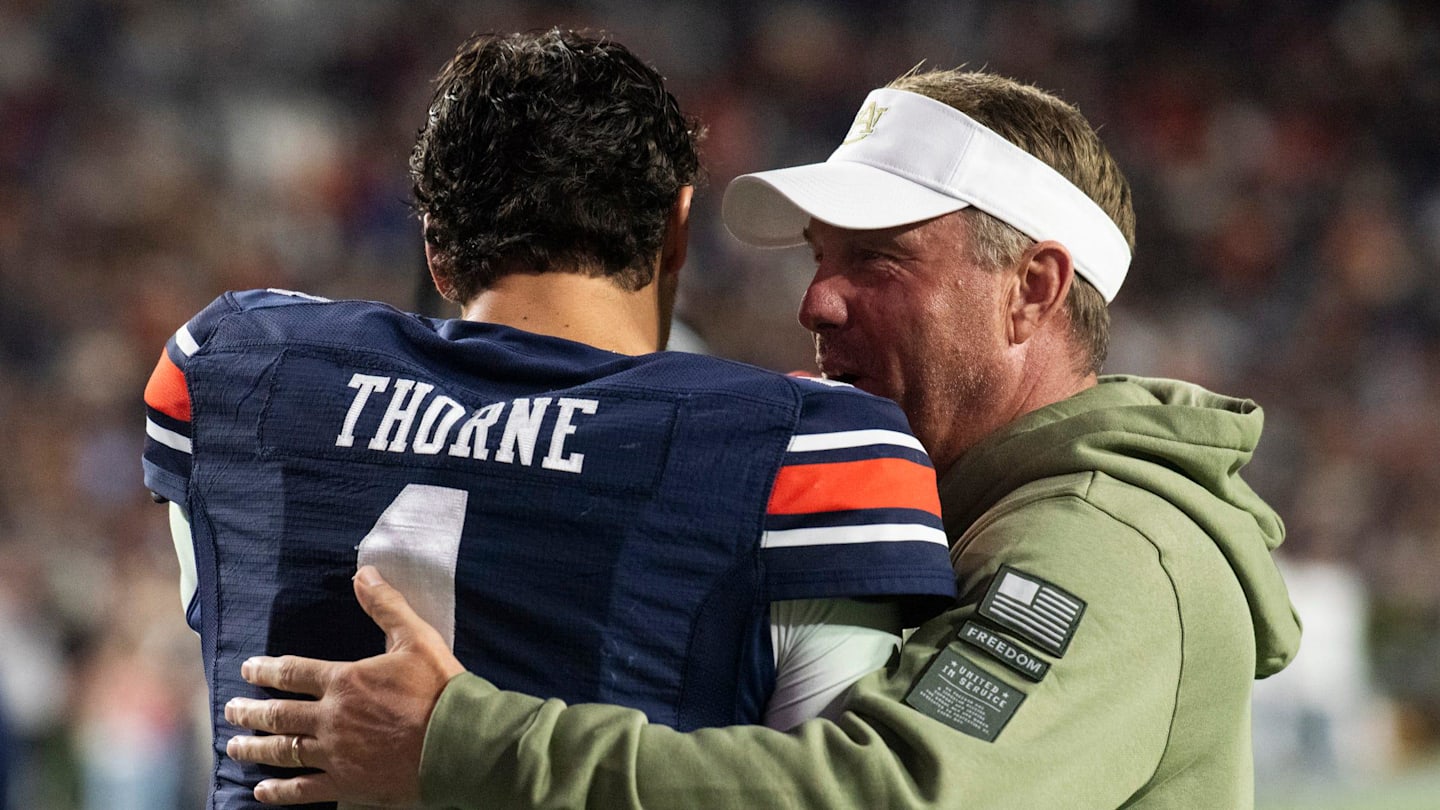Southwest
Meet the American who was the first paid professional football player: Pudge Heffelfinger
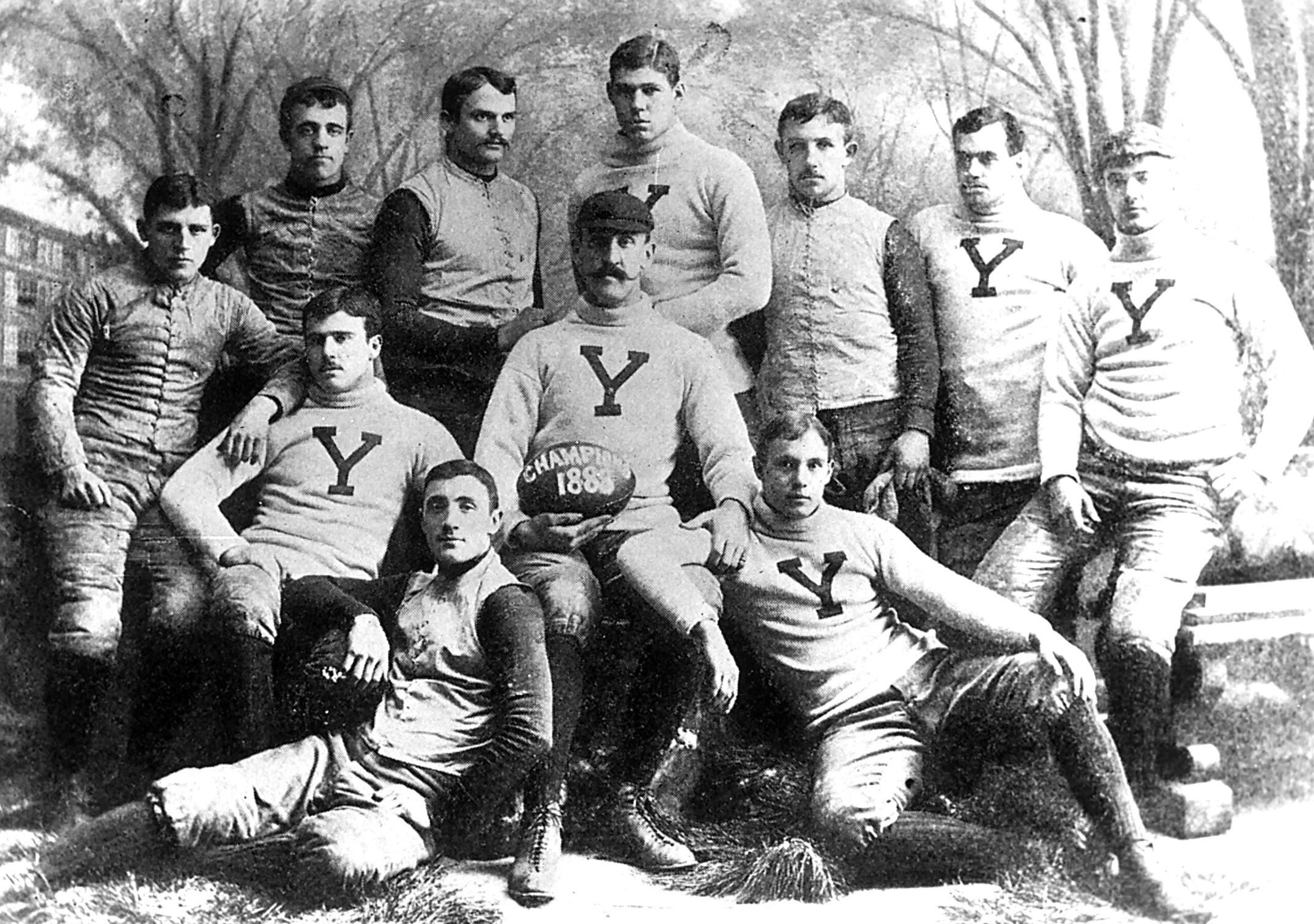
The name of the first professional football player seems too perfect to be true.
Pudge Heffelfinger sounds like a mythical Midwestern gridiron god more than a living, breathing human being.
Heffelfinger’s fable is actually nonfiction fare. He was as real as the broken ribs he brutally delivered to a poor college kid while scrimmaging for kicks and giggles with the Yale varsity football team — at 49 years old.
This groundbreaking goliath of American sports was “unquestionably the most amazing football player I had ever known,” legendary sportswriter Grantland Rice gushed in the introduction to Heffelfinger’s own book.
MEET THE AMERICAN WHO GAVE THE NATION OUR THANKSGIVING ORIGIN STORY: PILGRIM EDWARD WINSLOW
Heffelfinger was a Paul Bunyan-esque behemoth from Minnesota: tall, strapping, handsome and ferocious.
He starred for Yale from 1888 to 1891 and was the best player on some of the most dominant teams in college football history.
William Walter “Pudge” Heffelfinger was a strapping 6-foot-3, 205-pound lineman for the dominant Yale teams of 1888 to 1891. He became the first professional football player in 1892, when the Allegheny Athletic Association paid him $500 to play against the rival Pittsburgh Athletic Club. (Courtesy Pro Football Hall of Fame)
A year after manhandling overmatched amateur college opponents, Heffelfinger reshaped America’s favorite sport forever.
He was paid $500 to take the field for the Allegheny Athletic Association in an 1892 contest against the rival Pittsburgh Athletic Club.
“Pudge Heffelfinger was unquestionably the most amazing football player I had ever known.” — Grantland Rice
Heffelfinger entered history that day as the first known pro football player.
“Other players may have been paid to play before him — we don’t know for sure,” sports historian Ken Crippen, founder of The Football Learning Academy, told Fox News Digital.
“But Heffelfinger was the first for whom we have proof. After Heffelfinger … you were going to get the best players by throwing money at them.”
Heffelfinger proved to be one of the great ironmen in sports history. He played competitive football well into his 60s, after college as a barnstorming mercenary and in later years as a celebrity figure at charity games.
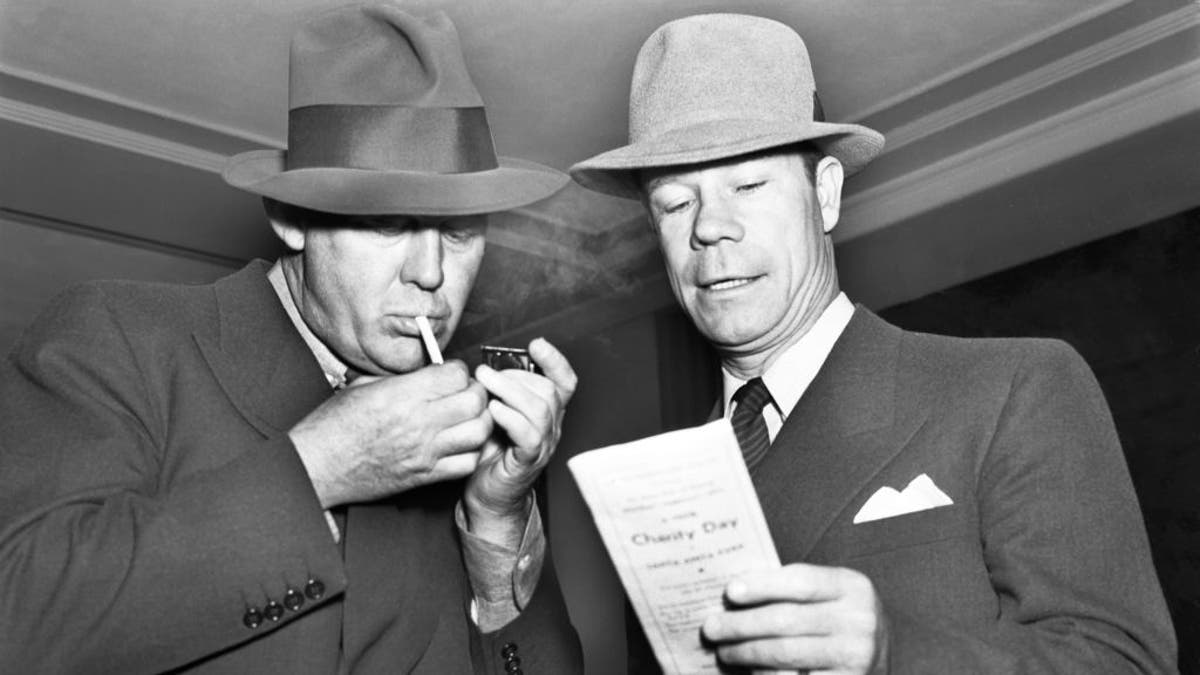
Grantland Rice, left, and Joe E. Brown, right, at the Santa Anita races. Rice is known for, among other things, crafting legendary phrases such as “The Four Horsemen of Notre Dame.” He called Pudge Heffelfinger “the most amazing football player I had ever known.” (Bettmann Archive/Getty Images)
Some sources put his last game at age 65, helping raise money for World War I veterans in 1932.
This super-human figure coached football, mentored players and championed football in media.
He helped popularize the game by publishing the annual “Heffelfinger’s Football Facts” from 1935 to 1950. It featured news, stats and schedules for both pro and college football.
MEET THE AMERICAN WHO SHAPED MODERN FOOTBALL: WALTER CAMP, PIGSKIN PIONEER
“It has been said by some historians that I will go down as ‘the greatest player of all time,’” Heffelfinger wrote in 1954, the year he died, in a biography called “This Was Football.”
“Deep in my heart I know it’s not true,” he added. “I can honestly claim, however, that I stuck with the game longer than anybody else did. On and off, I was an active football player 50 years.”
Born into new era of sports
William Walter “Pudge” Heffelfinger was born on Dec. 20, 1867, in Minneapolis to Christopher and Mary Ellen (Totton) Heffelfinger.
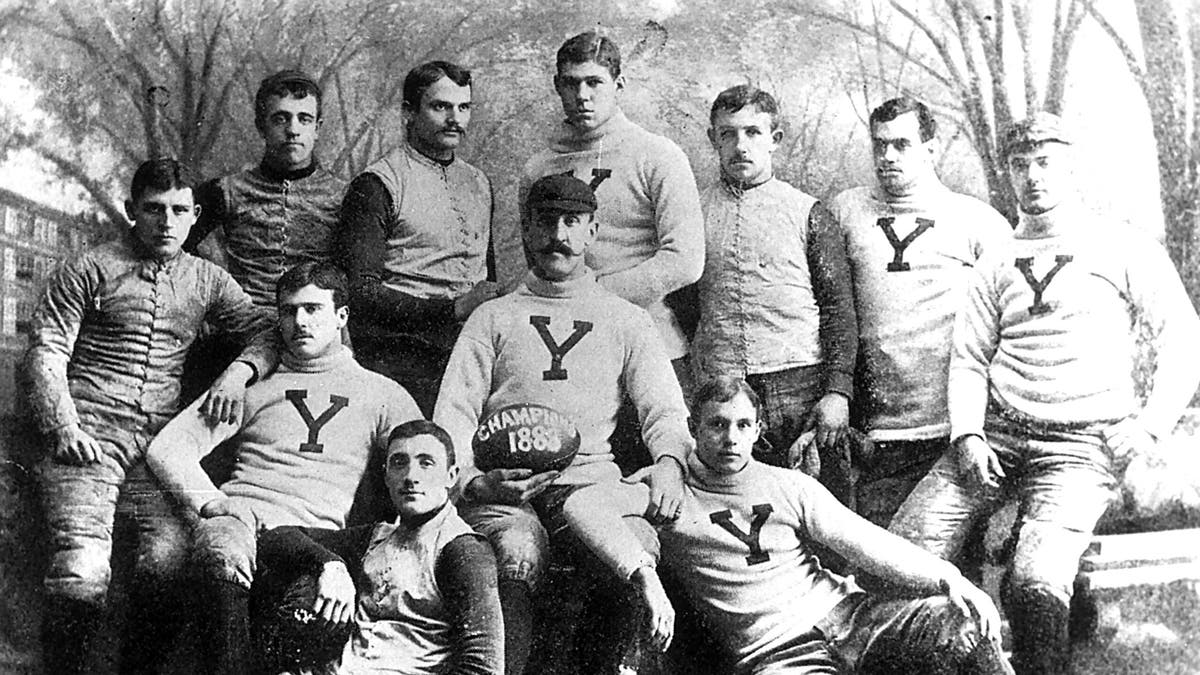
Yale University’s 1888 football team, coached by Walter Camp, went 13-0 and outscored its opposition 694-0. Pudge Heffelfinger (back row, center) towered over his teammates. (ullstein bild via Getty Images)
His father was a Civil War veteran wounded at Gettysburg, who then built a prominent shoemaking business in Minneapolis.
“Pudge wasn’t really pudgy,” Richard Goldstein wrote in “Ivy League Autumns,” published in 1996.
MEET THE AMERICAN WHO INSPIRED THE NATION IN TWO WORLD WARS: CHRISTIAN SOLDIER SGT. ALVIN YORK
“He picked up the nickname while playing sandlot football in Minneapolis at age 15.”
Heffelfinger was born into a nation on the cusp of the sport-as-entertainment explosion that followed the Civil War.
The Cincinnati Red Stockings, the first professional baseball team, played their first game in the spring of 1869. In the autumn of that same year, Rutgers and Princeton battled in the first college football game.
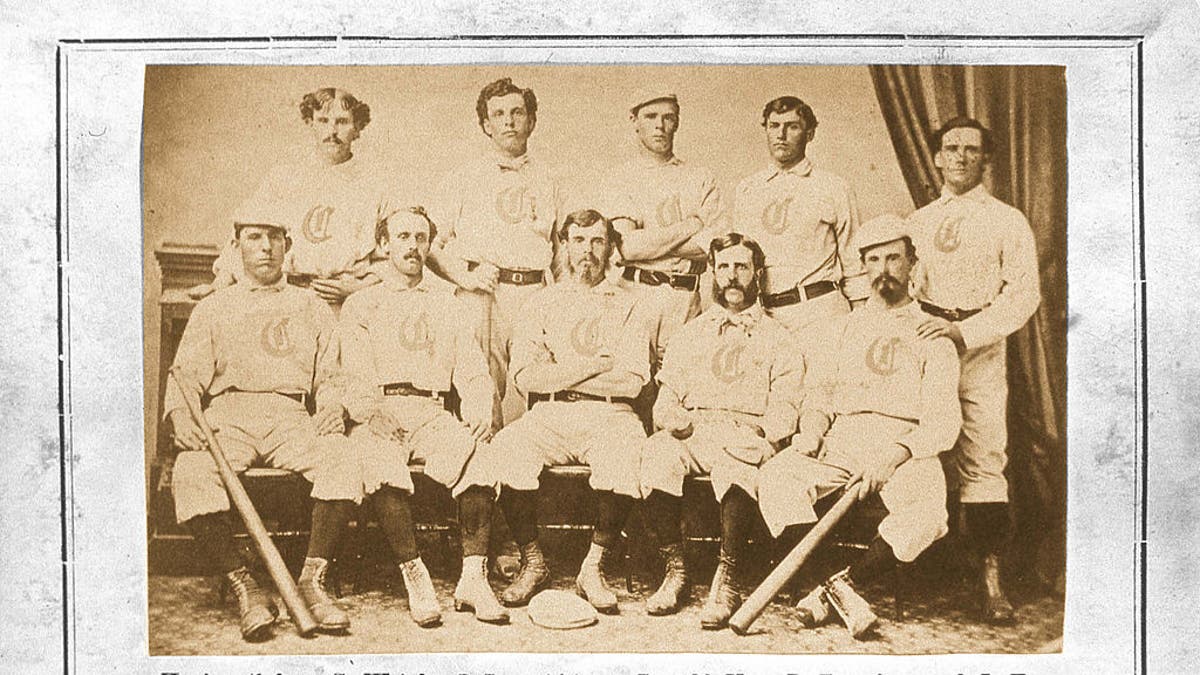
The Red Stocking Baseball Club of Cincinnati, Ohio, poses for a team photo in 1869, which was issued as a trade card. The Red Stocking, the first pro baseball team, and the first college football game, both emerged in 1869 — part of a post-Civil war obsession with sports as entertainment. (Mark Rucker/Transcendental Graphics, Getty Images)
Heffelfinger starred in both baseball and football at Central High School in Minneapolis. It’s the same high school that produced music legend Prince — before closing in 1982.
His athletic exploits gave Heffelfinger the opportunity to play at Yale, the best college program in America, under coach and pigskin pioneer Walter Camp, widely proclaimed as the father of modern football.
“Heffelfinger was extremely quick, powerful, intelligent and fearless,” Goldstein wrote. “He pounced on opponents while playing defense and led the line charge on offense, springing from a semi-erect stance.”
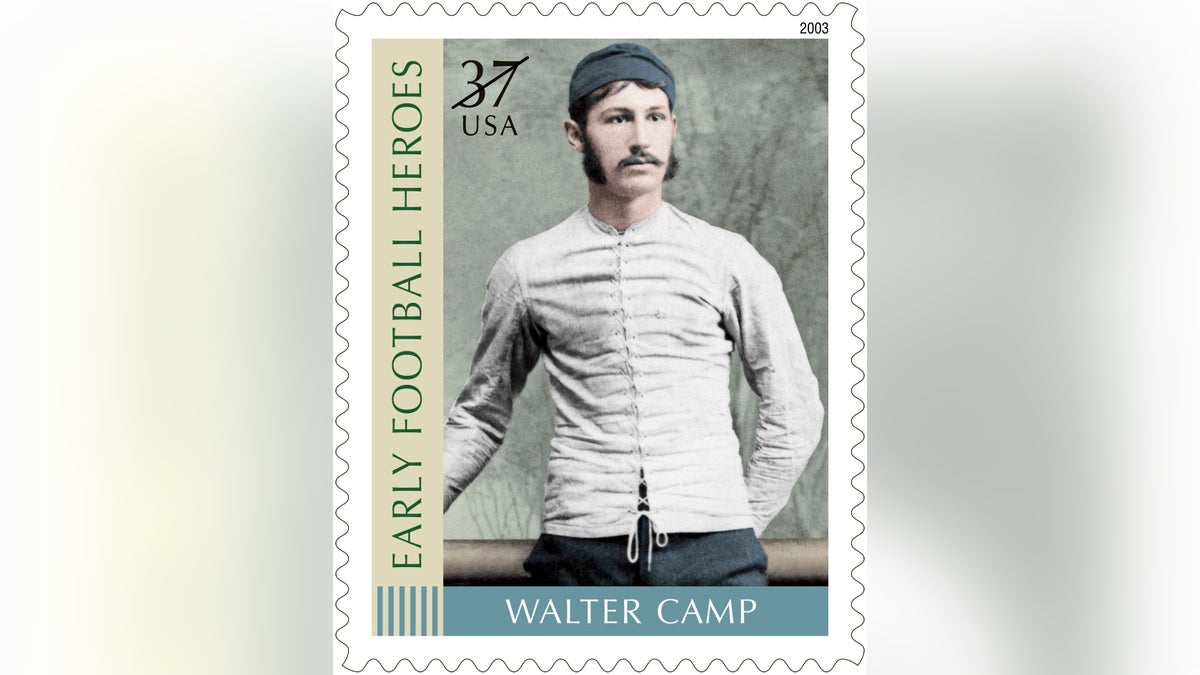
The U.S. Postal Service issued a Walter Camp stamp in 2003 to pay tribute to his unparalleled contributions to American football. Pudge Heffelfinger played for Walter Camp at Yale. (United States Postal Service)
Added Goldstein, “Heffelfinger’s specialty was moving to the right, then turning in to lead interference for a Tennessean named Thomas (Bum) McClung, Yale’s star halfback.”
Yes, Heffelfinger was football’s first pulling guard. It’s still a dramatic feature of the game today.
“Playing left guard, Heffelfinger was extremely quick, powerful, intelligent and fearless.”
Listed at 6 feet, 3 inches and 205 pounds, Heffelfinger was a giant in his day. Towering over his teammates, he helped Yale dominate college football.
He was a three-time All American performer and would have earned the honor four times, notes Goldstein, but for the fact that the award wasn’t introduced until his sophomore season.
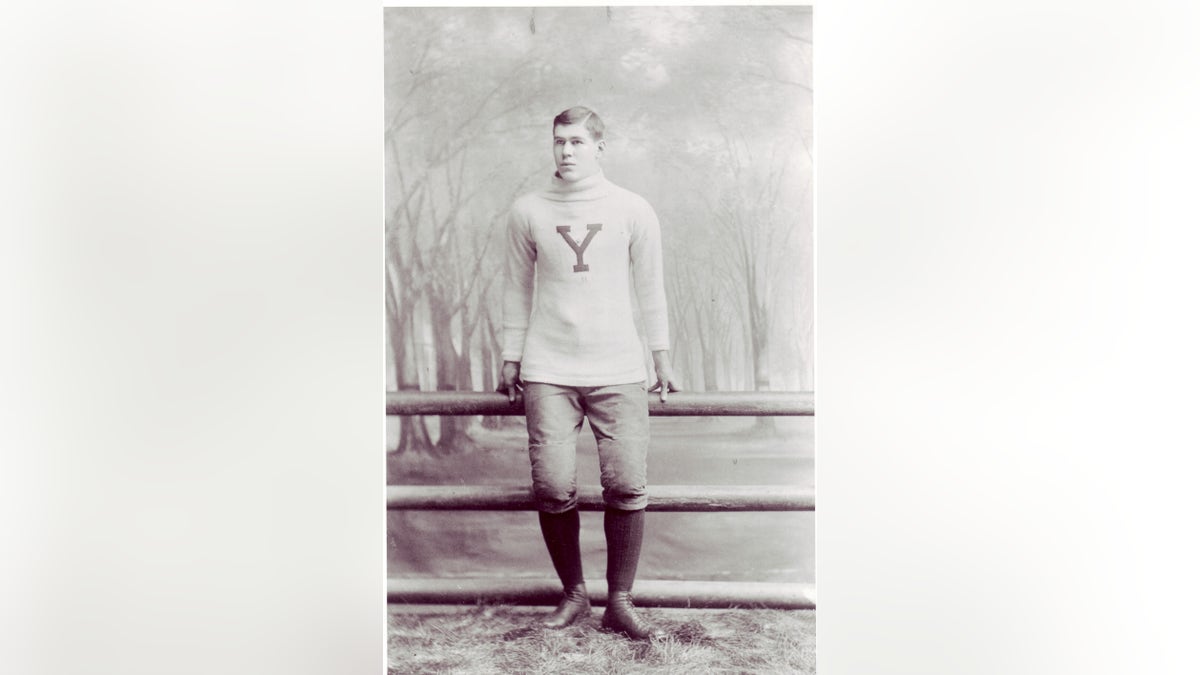
Pudge Heffelfinger starred at Yale from 1888 to 1891. Despite his nickname, he was not pudgy. But he towered over other players of the era. (Courtesy Pro Football Hall of Fame)
The 1888 Yale team, his freshman year, went 13-0 and outscored its opponents 694-0. It was the single most dominant team in more than 150 years of college football history.
“‘Pudge’ not only lettered in football, but he also lettered in baseball, rowing and track,” reports the Pro Football Hall of Fame.
He was reportedly the only four-letter athlete in Yale history and left Yale recognized as football’s greatest player.
Pro football’s birth certificate
Pro football of today grew out of community and company football clubs in the “Gridiron Breadbasket” of western Pennsylvania and Ohio.
These still-amateur teams were boosted by the growing popularity of college football.
ON THIS DAY IN HISTORY, NOV. 10, 1928, NOTRE DAME SHOCKS ARMY TO ‘WIN ONE FOR THE GIPPER’ AT YANKEE STADIUM
The Allegheny Athletic Association was founded on the north side of Pittsburgh in 1890, often fielding former college stars and competing against college programs.
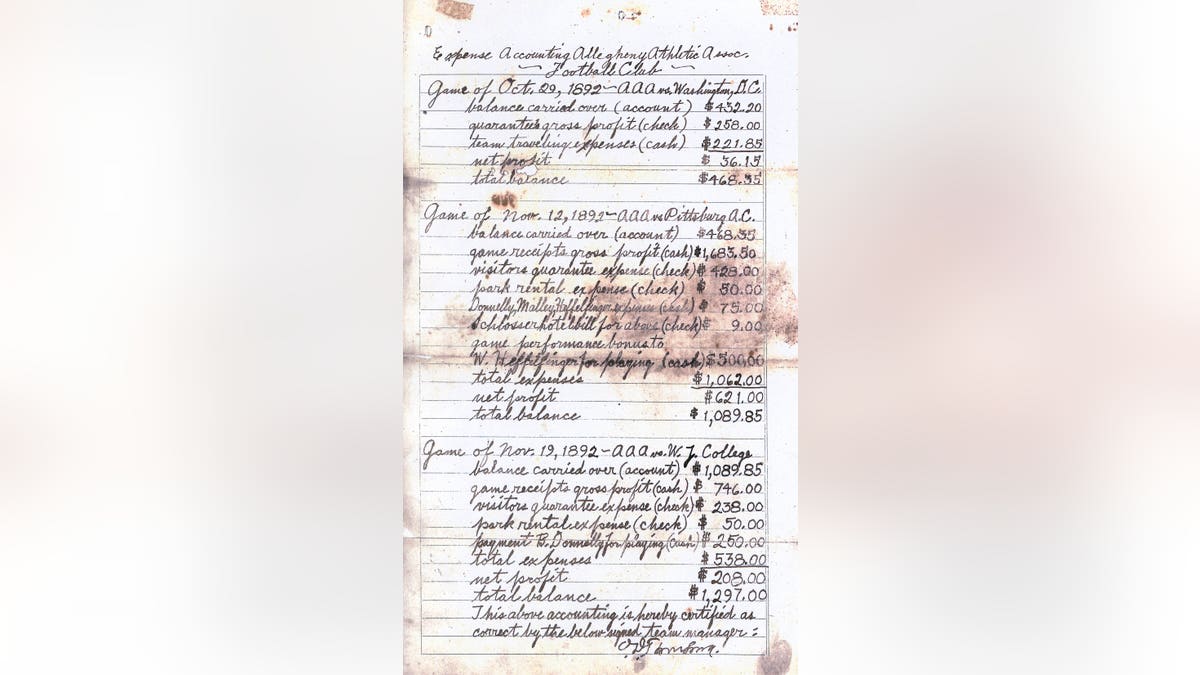
Pro football’s “birth certificate”: Dated Nov. 12, 1892, this Allegheny Athletic Club expense accounting sheet lists “game performance bonus to W. Heffelfinger for playing (cash) $500.00.” The ledger notation is the earliest evidence of a player being paid to play football. (Courtesy Pro Football Hall of Fame)
“The new club was a natural rival to the older Pittsburgh Athletic Club but labored under several disadvantages,” writes the Pro Football Researchers Association.
The “Triple A’s” sought to level the playing field the old-fashioned way: with money.
A handwritten ledger from the Allegheny Athletic Club shows an entry on Nov. 12, 1892 for “game performance bonus to W. Heffelfinger for playing (cash) $500.00.”
The Hall of Fame in Canton, Ohio, calls the document “Pro Football’s Birth Certificate.”
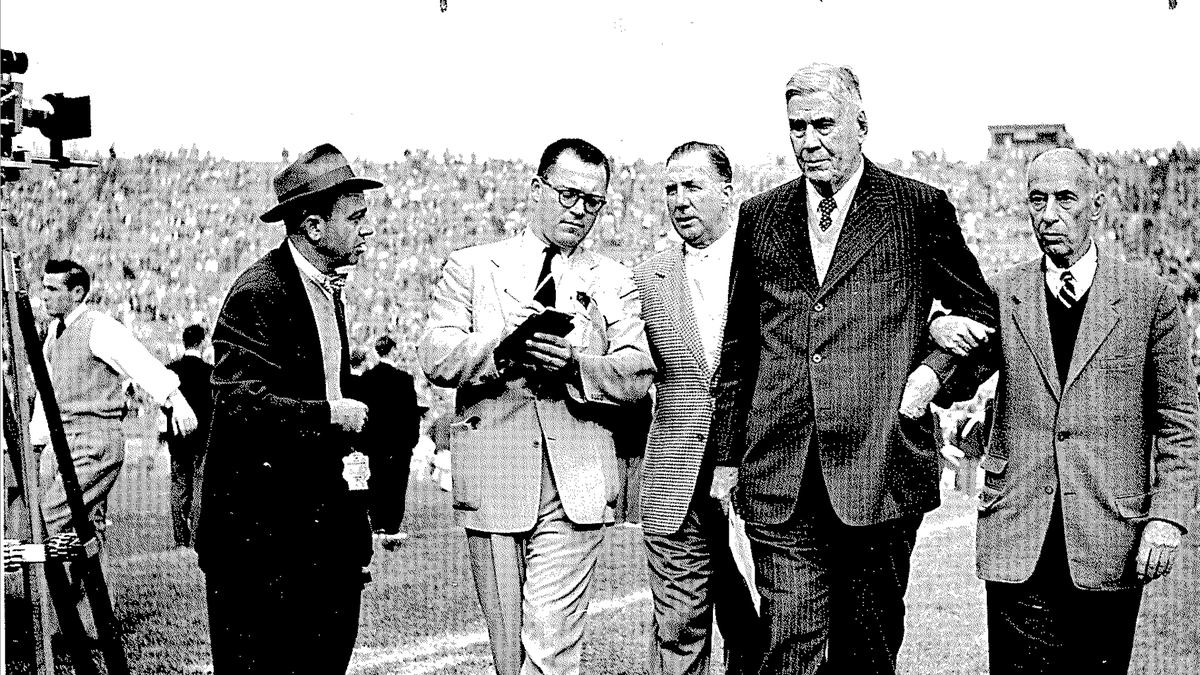
Pudge Heffelfinger was a Paul Bunyan-esque figure from Minnesota. He still towered over other men while being honored at an undated football game later in life. He continued to play football until his mid 60s. (Courtesy Pro Football Hall of Fame)
“Apparently, he was well worth it, as the Allegheny Athletic Club defeated the Pittsburgh Athletic Club, 4-0,” writes the Pro Football Hall of Fame.
“Heffelfinger recovered a fumble and returned it [25 yards] for a touchdown for the game’s only score. Touchdowns were worth just four points in 1892.”
The Allegheny Athletic Club netted a tidy $621 profit for the day, despite devoting nearly half the team’s $1,062 in expenses to Heffelfinger. The payout was big money at the time.
“The average annual income of a Pennsylvania family in 1892 was $834,” Pudge’s great-great-nephew, Tom Heffelfinger, told the Minneapolis Star-Tribune in 2018.
MEET THE AMERICAN WHO FIRST COMMANDED THE MARINES: REVOLUTIONARY WAR HERO SAMUEL NICHOLAS
The story of Pudge Heffelfinger, the first professional football player, lived on only through word of mouth and hazy legend for nearly 75 years.
History changed in the 1960s when a mysterious man walked into the office of Pittsburgh Steelers president Dan Rooney.
“After a brief discussion, the man gave Rooney a typed, 49-page manuscript about the early history of pro football,” the Pro Football Researchers Association reported in 1989.

In this Feb. 5, 2017, file photo, New England Patriots’ Tom Brady raises the Vince Lombardi Trophy after defeating the Atlanta Falcons in overtime at the NFL Super Bowl 51 football game in Houston. Pro football today is about a $19 billion-a-year business. (AP Photo/Darron Cummings, File)
“When Rooney read the paper, he realized he had a piece of research of incalculable importance. Unfortunately, by that time, the man had departed.
As best Rooney could recall, the visitor’s name was Nelson Ross. But although Rooney tried to track down Ross, the man never resurfaced.
The Pro Football Hall of Fame dug into the story, and found in its files the ledger entry from the Allegheny Athletic Association showing the details of the day it made Heffelfinger the first pro football player.
The practice of paying players was formalized in 1920 with the creation of the American Professional Football Association. Two years later, it was renamed the National Football League.
‘Forever young’
William Walter Heffelfinger died on April 2, 1954, in Blessing, Texas. He was 86 years old.
The Texas Historical Commission memorialized the football great with a signpost tablet placed outside his burial site at Hawley Cemetery in Blessing.
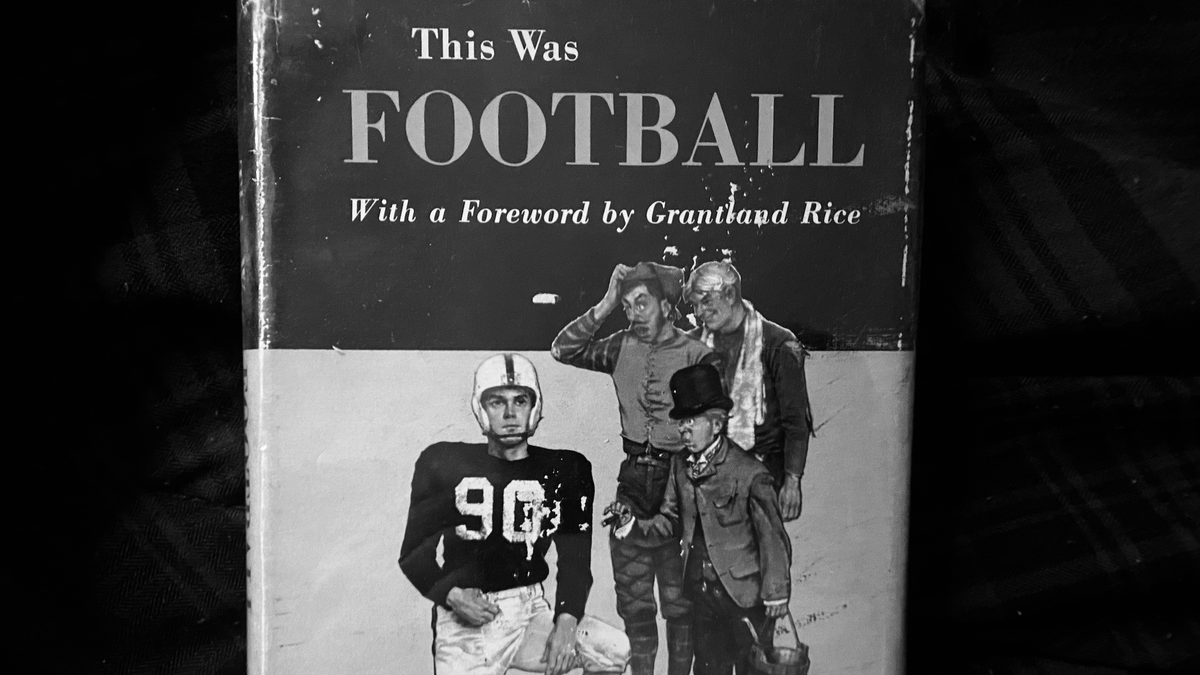
Wiliam Walter “Pudge” Heffelfinger, who played football into his 60s, chronicled his groundbreaking sports journey in the 1954 book, “This Was Football.” (Kerry J. Byrne/Fox News Digital)
It highlights his many contributions to the game, including his advent of the pulling guard and his induction into the College Football Hall of Fame in 1951.
Heffelinger enjoyed quite a life outside football, as politician, businessman and media mogul.
“Pudge gave forth an aura of shining light, a special, ageless glory … the living symbol of the game, indestructible and forever young.”
“He was a Minnesota delegate to the Republican National Conventions in 1904 and 1908. He served as Hennepin (Minnesota) County Commissioner from 1924-48 and even ran, although unsuccessfully, for Congress in 1930,” writes the Pro Football Hall of Fame.
But it was the moment in 1892, when his $500 exploits paid off in victory for the Allegheny Athletic Association, that heralded a new era in American culture.

Then-Green Bay Packers quarterback Aaron Rodgers, number 12, jogs toward the locker room after the Packers defeated the San Francisco 49ers 30-28 at Levi’s Stadium in Sept. 2021. (Cary Edmondson-USA TODAY Sports)
Professional football today is the great colossus of global sports.
Its popularity in America is rivaled only by college football; its profitability around the world is matched by no other sport.
For instance, the National Football League generated $17.2 billion in revenue in 2021.
Today, it’s roughly a $19 billion-a-year business.
Game-day pay has also grown dramatically in the numerous autumns since Pudge pocketed five bills.
Heffelfinger likely would have marveled at all the changes.
“I’d love to live another 86 years — just to see what’s around the corner!” he enthused in his book, “This Was Football,” published the year he died.
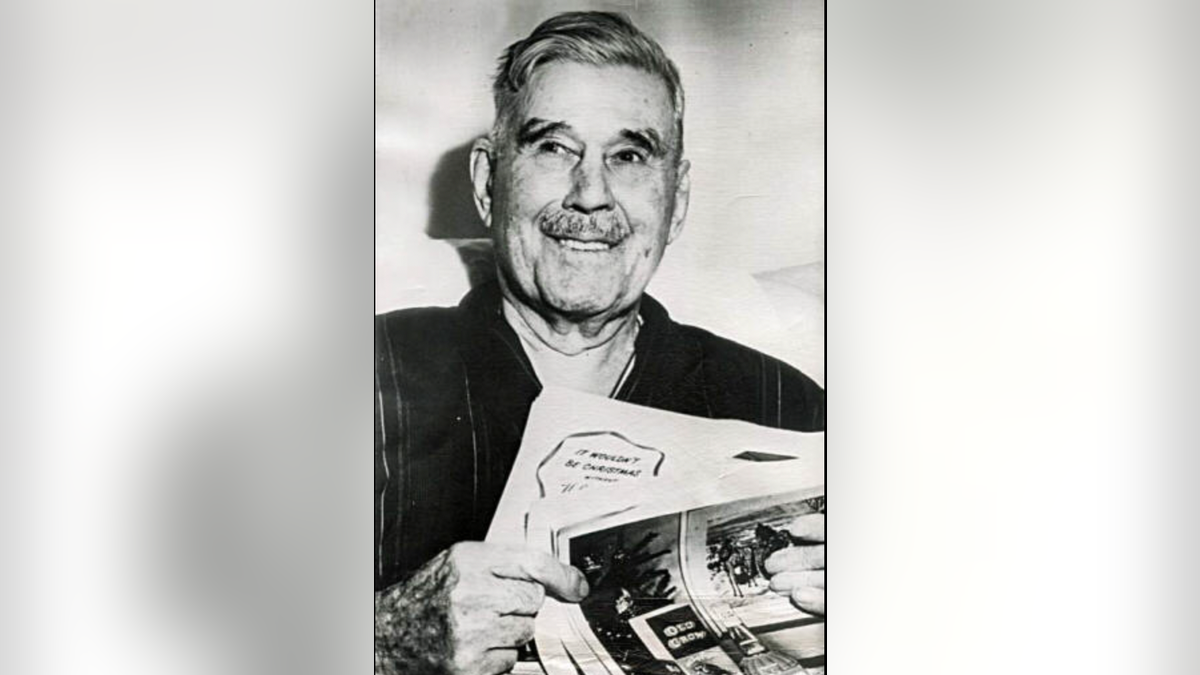
Pudge Heffelfinger at age 82 in Blessing, Texas, around 1950. He died at age 86 in 1954. Heffelfinger was the first athlete paid to play football. He continued to play competitive football until age 64. (Public Domain)
Grantland Rice dug deep into the well of English-language literature to find ways to pay homage to Heffelfinger.
To read more stories in this unique “Meet the American Who…” series from Fox News Digital, click here.
“To borrow a line from old Bill Shakespeare: ‘Cowards die many times before their death. The valiant never taste of death but once,” wrote Rice.
For more Lifestyle articles, visit www.foxnews.com/lifestyle
“Pudge gave forth an aura of shining light, a special, ageless glory. He was the living symbol of the game, indestructible and forever young.”
Read the full article from Here

Southwest
Texas man convicted after saying he mutilated victims, ate human heart as part of 'ritualistic sacrifices'

A Texas man was convicted of killing three people, dismembering them and burning their bodies after admitting to investigators that he was called to “commit sacrifices.”
Jason Thornburg was found guilty of capital murder on Wednesday and now, the same Tarrant County jury that convicted him must determine whether he receives a death sentence or if he will spend the rest of his life in prison without the possibility of parole, according to Fox 4.
In September 2021, Thornburg killed three people, dismembered their bodies and stored them under his bed at a motel in Euless, Texas, before lighting the bodies on fire inside a dumpster in Fort Worth.
TEXAS LAWMAKER PROPOSES BILL TO ABOLISH DEATH PENALTY IN LONE STAR STATE: ‘I THINK SENTIMENT IS CHANGING’
Jason Thornburg (Tarrant County Jail)
Thornburg confessed to investigators that he felt a compulsion to commit “ritualistic sacrifices” and that he ate a victim’s heart and other parts of the victims’ bodies.
His attorneys argued he was insane when he carried out the murders and suffered from a severe mental disease.
ELDERLY MAN ACCUSED OF ROOMMATE AND DOG’S ‘BRUTAL’ MURDER HAD EXTENSIVE CRIMINAL RECORD

Thornburg confessed to investigators that he was being called to “commit sacrifices” and that he ate a victim’s heart and other parts of the victims’ bodies. (iStock)
When he was arrested on murder allegations, Thornburg confessed to police he killed his roommate in May 2021 during a suspicious home explosion and his girlfriend in Arizona back in 2017.
These two previous murders were brought up in court on Thursday when the punishment aspect of the trial began.

The jury must now determine whether he receives a death sentence or if he will spend the rest of his life in prison without the possibility of parole. (iStock)
The victims’ families cannot speak publicly until the punishment phase is finished.
Read the full article from Here
Los Angeles, Ca
Vehicle, 2 occupants plunge into crowded Southern California harbor

Two people were taken to the hospital after a vehicle they were inside plunged into the harbor Sunday night in Marina Del Rey, officials confirmed to KTLA.
Details are limited and It’s unclear exactly how the incident occurred, but authorities with the Los Angeles County Fire Department responded to 4675 Admiralty Way just after 6 p.m. on reports of the vehicle in the water.
L.A. County Fire Department Public Information Officer Marco Rodriguez said the two occupants were able to get themselves out of the vehicle after it went into the water.
Both were examined by medical personnel with the fire department and taken to a nearby hospital in unknown condition.
Rodriguez said that two L.A. County Lifeguard divers were deployed to ensure there were no other occupants trapped in the vehicle.
A witness, Johnny Hamcheck, told KTLA that a third person, a woman, exited the vehicle before it went into water, though officials did not confirm that detail.
Footage of the recovery effort showed crews attaching large yellow floating devices to the vehicle as it was anchored to a crane and eventually pulled out of the water and loaded onto a tow truck.
The vehicle showed heavy front-end damage, presumably from crashing through the steel railing and into the water.
An investigation into the crash is ongoing and no further details were provided.
Southwest
24 states' attorneys general call on Supreme Court to keep biological boys out of girls sports

Attorneys general from 24 states are urging the U.S. Supreme Court to overturn a lower court ruling and uphold an Arizona law to prohibit biological boys from competing on girls’ sports teams.
The petition comes after a federal appeals court ruled that the law likely violates the Equal Protection Clause of the Constitution.
“Sports teams are divided by sex to begin with to give girls a level playing field so they’re not competing against boys,” South Carolina Attorney General Alan Wilson said in a news release. “Arizona’s law restricting girls’ sports teams to biological females is just common sense, and it protects girls from competing against bigger, stronger males who identify as females.”
FEDERAL JUDGE PUSHES BACK ON PARENTS CALLING TRANS ATHLETE ‘A BOY’ IN LEGAL BATTLE OVER PRO-GIRLS PROTESTS
Alan Wilson (Getty Images)
In addition to Wilson, the attorneys general supporting the petition are those from Alabama, Alaska, Arkansas, Florida, Georgia, Indiana, Iowa, Kansas, Kentucky, Louisiana, Mississippi, Missouri, Montana, Nebraska, New Hampshire, North Dakota, Oklahoma, South Dakota, Tennessee, Texas, Utah, Virginia and Wyoming.
The petition notes that these states have laws similar to Arizona’s that restrict girls’ sports to biological females.
It also argues that the Equal Protection Clause does not prohibit states from offering separate sports teams for men, women, boys and girls.
GIRLS CATHOLIC SCHOOL VOLLEYBALL TEAM COULD FACE PENALTY AFTER FANS BOO TRANS ATHLETE ON PUBLIC SCHOOL TEAM

The U.S. Supreme Court in Washington, D.C., on Tuesday, Feb. 28, 2023. (Valerie Plesch/Bloomberg via Getty Images)
“In sports, equal access means a level playing field,” the attorneys general write in their brief. “And a level playing field usually means sports teams divided by sex so that girls can compete against other girls.”
“Basing the distinction on biology rather than gender identity makes sense because it is the differences in biology—not gender identity—that call for separate teams in the first place: Whatever their gender identity, biological males are, on average, stronger and faster than biological females. If those average physical differences did not matter, there would be no need to segregate sports teams at all,” they continued.

The petition argues that the Equal Protection Clause does not prohibit states from offering separate sports teams for men, women, boys and girls. (ALLISON DINNER/AFP via Getty Images)
The attorneys general are asking the high court to “make it clear that the Constitution does not prohibit states from saving women’s sports from unfair competition and providing meaningful athletic opportunities for girls and women,” according to Wilson’s news release.
Read the full article from Here
-

 Business1 week ago
Business1 week agoColumn: Molly White's message for journalists going freelance — be ready for the pitfalls
-

 Science6 days ago
Science6 days agoTrump nominates Dr. Oz to head Medicare and Medicaid and help take on 'illness industrial complex'
-

 Politics1 week ago
Politics1 week agoTrump taps FCC member Brendan Carr to lead agency: 'Warrior for Free Speech'
-
/cdn.vox-cdn.com/uploads/chorus_asset/file/25739950/247386_Elon_Musk_Open_AI_CVirginia.jpg)
/cdn.vox-cdn.com/uploads/chorus_asset/file/25739950/247386_Elon_Musk_Open_AI_CVirginia.jpg) Technology7 days ago
Technology7 days agoInside Elon Musk’s messy breakup with OpenAI
-

 Lifestyle1 week ago
Lifestyle1 week agoSome in the U.S. farm industry are alarmed by Trump's embrace of RFK Jr. and tariffs
-

 World1 week ago
World1 week agoProtesters in Slovakia rally against Robert Fico’s populist government
-

 News1 week ago
News1 week agoThey disagree about a lot, but these singers figure out how to stay in harmony
-

 Health2 days ago
Health2 days agoHoliday gatherings can lead to stress eating: Try these 5 tips to control it











